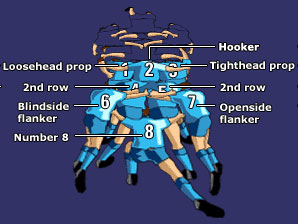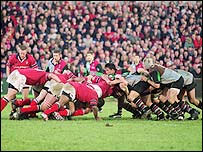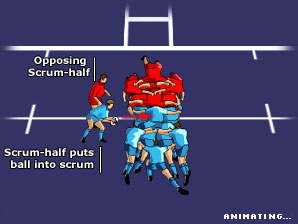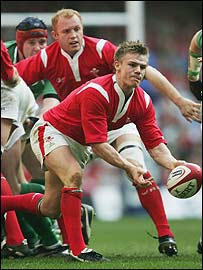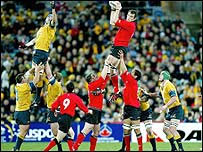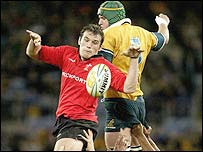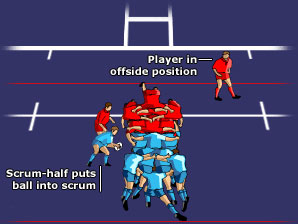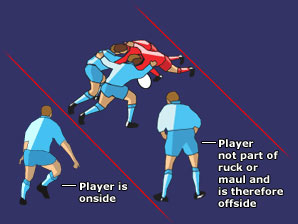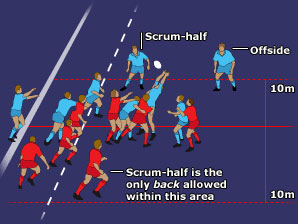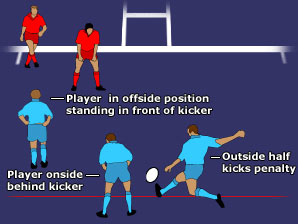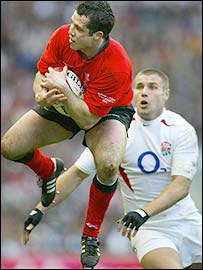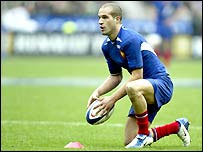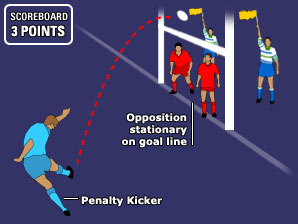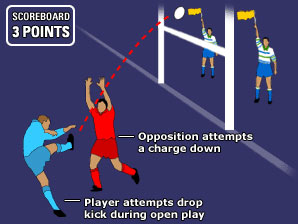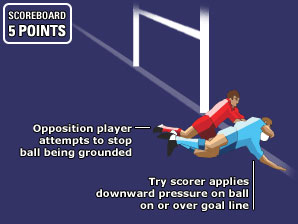|
The
positions on the rugby pitch
The
beauty of rugby union is that is a game for people of all shapes
and all sizes. Traditionally,
forwards tended to be larger and less mobile, while backs were
smaller and faster. However,
rugby has changed and players of shapes and sizes are playing in
different positions to what their body types. Whether
you are short and stocky or tall and thin, there's a place for you
in a rugby side. |
|
FULL
BACK The
modern-day full-back should be the complete rugby player. The
number 15 is often the last line of defence or the first player
making the break in attack. Full-backs
need a safe pair of hands because they are the player responsible
for catching the opposition's high and testing kicks in attack. Expect
to perform under pressure when the going gets seriously tough. If you
can suddenly turn defence into attack, make those important
last-ditch tackles and make the extra man in attack, look no
further than the full-back. |
|
WINGER
Often
the fastest runners on the team are to be found on the wing. Their
main responsibility is to finish off the attacking moves created
by their fellow backs and score tries. Sidesteps,
swerves and dummy passes - as well as a change of pace - are the
main skills wingers use to evade the tacklers. However,
they also need to have the all-round skills of a full-back as
often they can find themselves the last line of defence as well as
the first point of attack. |
|
INSIDE
CENTRE The
inside centre is one of those players who is always involved,
whether in defence or attack. They
offer options for the fly-half in attack, making the breaks and
drawing the opposition's defence to make the space for their
partner, the outside centre. And
the inside centres are also the players tackling in defence along
with the forwards. Accurate
handling and passing skills are a must for any centre, along with
a good kicking game. Expect
to get through plenty of running. |
|
OUTSIDE
CENTRE The
outside centre is the player who exploits the gaps in the
opposition's defence. They
often hit the holes in the opposition's defence, making valuable
ground and offloading to the wingers after drawing the last line
of defence. They
also need a sturdy defensive game, like their partner the inside
centre. Accurate
handling and passing skills are a must for any centre, along with
a good kicking game. |
|
FLY
HALF The
fly-half is probably the most influential player on the pitch as
they are the brains of the whole team. They
are the players who make the big decisions under pressure - to run
with the ball or kick for territory. So it
goes without saying fly-halves need excellent handling skills and
a confident kicking game. But as
well as attacking instincts, the fly-half also needs to have a
solid defensive game. As well as being one of the best kickers in world rugby, Jonny Wilkinson is one of the hardest tacklers around |
|
SCRUM
HALF The
scrum-half is the link between the backs and the forwards - the
players who get things going in defence and attack. They
collect the ball from scrums and line outs from the forwards to
provide possession for the backs. They
also Scrum-halves
need to be accurate passers as well as fast decision makers in
tight situations. |
|
LOOSEHEAD
PROP A
loosehead prop is one of the three players at the front of the
scrum. They
stand on the left-hand side of the hooker. As
they take most of the impact in the scrum, a prop should have
plenty of strength in their upper body. This
is the area of the body where all the power is created for the big
push. |
|
TIGHTHEAD
PROP A
tighthead prop is one of the three players at the front of the
scrum. They
stand on the right-hand side of the hooker. As
they take most of the impact in the scrum, a prop should have
plenty of strength in their upper body. This
is the area of the body where all the power is created for the big
push. Props
also tend to get stuck into tackles and often they can be found at
the bottom of a ruck or the middle of a maul. |
|
HOOKER
Out
of all the eight forwards, the hooker is the one player with the
most responsibility. They
have two very important roles to play. Their
first duty is to hook the ball for the scrum-half to collect in
the scrum. And
their second is to throw the ball in at the line-outs for the
jumpers to catch. This
is often done under intense pressure - so hookers need plenty of
nerve and confidence. Like
props, hookers need to have a strong back and neck, as well as
powerful arms and legs. But
they need to be that bit more flexible than their fellow front row
mates because they are the ones who hook the ball in the scrum. Hookers
are often the smallest member of the forwards, but that doesn't
mean they are the least important. |
|
SECOND
ROW Most
second rowers or locks are tall and powerful. As
well as providing power for the big push in the scrum, the second
row are the targets in the line-out. Their
job is to catch the hooker's throw and get the ball to the
scrum-half. Modern-day
second rows need to be mobile around the park to carry the ball
and to make tackles. |
|
OPEN-SIDE
FLANKER The
modern-day flanker is an all-round athlete, combining speed, power
and skill into one position. The
openside flanker is usually a slightly different build from their
partner, the blindside flanker. They
are smaller in size, making them more mobile around the pitch. One of
their main roles is to win ball from the opposition, which means
battling for possession at rucks and breakdowns. The
openside flanker will often be the player with the responsibility
to mark the other side's fly-half. They
do this by quickly closing them down, reducing the time they have
to kick or pass. Because
of their high tackle count, flankers are always involved in rucks
or mauls either at the bottom or making the big drives. |
|
BLINDSIDE
FLANKER The
blindside flanker tends to be bigger than their team-mate, the
openside flanker. They
have a more physical role and are often a target for the hooker in
the line-out. They
get through a large amount of tackles and are often regarded as
the "invisible" player because of the work they get
through. |
|
NUMBER
8 The
number 8 is the player who controls the ball at the back of the
scrum. They
have a similar role to the flanker in terms of getting through the
hard work of tackling, rucking and mauling. Number
eights need to have explosive pace and power, especially when the
scrums are near the opposition's tryline. They
are also a potential target for the hooker in the line-out. |
|
SUBSTITUTES
Substitutes
are the players who start the match on the bench, rather than on
the pitch. There
are two types of substitutes in rugby union - temporary and
permanent replacements. The
temporary substitutes come on for any player who has been sent to
the blood-bin. But
they must return to the bench once the injured player has returned
to the pitch. But if
the injured player has not returned to the field within 15
minutes, they become permanent. Permanent
replacements are substitutes who come on as a direct replacement
for a player on the pitch. The
substituted player is not allowed to return to the pitch. |
|
Forming
a scrum
The
eight forwards are the players who form the scrum. The
hooker, two props, two second rows, two flankers and the number 8
all bind together in a 3-4-1 formation, ready to lock heads with
the opposition. The
hooker Two
props Two
second row forwards Two
flankers Number
8 |
|
Feeding
the scrum
The
scrum-half is the player who gets things going in the scrum. It is
their job to feed the ball into the scrum for the hooker to strike
back to the number eight. The
scrum-half must roll the ball in from the left-hand side, or the
loosehead side as it is called. The
scrum-half must then not handle the ball until it has come out of
the scrum. The
six other backs must be at least five metres behind the last
forward of their team. If
they are not, the referee will penalise the offending team. |
|
|
Hooking
the ball
Their
job is to strike the ball back to the number 8 once the scrum-half
has fed the ball into the scrum. This
is not as easy as it sounds. Why?
Because the opposition's hooker is trying to steal the ball from
you. Plus
you've got eight huge forwards on the other side trying to push
you off the ball. The
hooker is the only player in the scrum who can raise their feet -
otherwise they would never be able to strike the ball. However,
no other player in the scrum is allowed to handle the ball until
the ball is free - not even the hooker. |
|
|
When
is a scrum ended?
A
scrum is finished when the ball has come out of the scrum. Once
it has, then the opposition scrum-half can tackle their opposite
number for the ball. But in
some situations the number 8 may dribble with the ball, keeping it
in the scrum. This
means the opposing scrum-half cannot get their hands on the ball
because it's still in the scrum. This
often happens when the team in possession have an attacking scrum
near their opponent's try line. RETAKING
A SCRUM The
referee is in charge on the pitch and if he's not happy with a
scrum, he can order it to be re-taken again when: · The
scrum has rotated 90 degrees · The
scrum has collapsed before the ball has been fed or before the
ball has come out · The
ball does not come out quick enough |
|
What
is a line-out?
The
line-out is another awesome sight in rugby union. It is
a way of restarting play after the ball has been knocked or kicked
out of play past the touch line. The
line-out consists of three to eight players from each side, up to
16 in total, and is taken where the ball went out of play. The
aim of each player is simply to get their hands on the ball for
their team. So how
does it work? The advantage is with the team throwing in. They
get the ball because they were not the team who last touched the
ball before it went out. They also get to decide how many players
will make up the line-out. FORMING
A LINE-OUT
The
eight forwards and the scrum-half are the players who make up the
line-out. The
most important players are the hooker, the two second rows and
scrum-half. They are responsible for getting the ball out to the
backs or for the rest of the forwards. That
does not mean the other players have nothing to do. Far from it. The
line-out must be formed past the five-metre line and no more than
15m in from the touchline, and both teams must have a one metre
gap between them. If the
referee decides one team has purposely closed the gap, a penalty
will be awarded to the other team. LINE-OUT
THROWS The
hooker is usually the player with the job throwing the ball into a
line-out. Their aim is to find the "jumpers", usually
the two second rowers. But
this is not easy. The other team also want the ball, so they'll be
doing all they can to upset the hooker's throw. The
hooker gets a call from one of the jumpers or the scrum half,
usually in a code no-one except your team understands, on who to
aim the throw at. They
must stand behind the touch line when they make their throw. And
the throw must be deadly straight, otherwise the referee will have
the line-out taken again, but this time the opposition get the
throw in. RETAKEN
THROWS
The
line-out may look very simple, but it has plenty of laws every
player must follow: · The
ball must be thrown straight · All
players not in the line-out must be 10m behind the last man in the
line · No
player can use a one of the opposition to use as support when they
are jumping · No
player is allowed to push, charge or hold another player in the
line-out · No
player can be lifted before the ball is thrown · No
jumper can use the outside of their arm to catch or deflect the
ball Depending
on how serious the offence is, the referee will either award a
penalty or free-kick to the team who did not make the offence. |
|
When
the sin-bin calls This
is a place you should avoid at all costs. The
sin-bin is the bench where all players who have committed an
offence sit out of the game for 10 minutes. If the
referee believes a player has committed a serious foul or shown
indiscipline, then he will show them a yellow card, just like in
football. However,
unlike football, that player must then immediately leave the
pitch. They
then have to sit in the sin-bin for 10 minutes while the game
continues without them. With
an extra player for that duration it is obviously a perfect time
to push for extra points. |
|
The
lowdown on the offside law
Offside
is quite a complicated rule of rugby union, but it can be broken
down into phases of the game. If you
are in front of a team-mate in possession of the ball, or in front
of a team-mate who last played the ball, you will be offside if: · You
actively try to play the ball · You
don't get back within 10m of an opponent who's waiting for the
ball · You
move towards the opponents or the place where the ball lands
without first coming back onside The
referee will award a penalty at the place where the offence took
place. OFFSIDE
AT A SCRUM
For
scrum-halves, the offside line is the line of the ball fed into
the scrum. So
that means they can't go past that line until the ball has been
put into the scrum by the opposing number nine. For
all the other players, the offside line is an imaginary line drawn
through the foot of the last player in the scrum. No
player apart from the eight forwards and scrum-halves are allowed
in this area. The
opposing scrum-half has to wait until the ball is fully out of the
scrum before making a tackle for the ball. If
they don't, then the referee will be on their case and give a
penalty. OFFSIDE
AT A RUCK OR MAUL
Most
offside decisions in rugby union happen at rucks and mauls,
especially when the ball is being recycled a lot. Like
the scrum, an imaginary line is drawn through the foot of the last
player in the ruck or maul. Players
must either join the ruck or maul or get behind the offside line. A
player is offside at a ruck or maul if: ·
They join in from their opponent's side ·
They join play from in front of the last man in the ruck or maul ·
They do not join either the ruck or maul, but fail to get behind
the offside line ·
They leave the ruck or maul, but do not get behind the offside
line. OFFSIDE
AT A LINE-OUT
There
are two different imaginary offside lines for players in the
line-out and those outside the line-out. Effectively
they make a box which is 10m wide either side of the line-out. Only
the forwards and the scrum-half are allowed in this area until the
ball has been thrown in, touched a player or the touched the
ground. A
player is offside at a line-out if: ·
They have gone beyond the line of the throw before the ball has
touched a player or the ground, unless they are jumping for the
ball. ·
Once the ball has been touched by hand or hits the ground, a
player has gone beyond the ball unless they are tackling, or
attempting to tackle, a member of the opposing team. OFFSIDE
AT A KICK
If one
of your team-mates is about to kick a high up-and-under or a
cheeky little grubber kick for you to run onto, make sure you are
level or just behind them when they kick. If you
are not, the referee will award your opponents a penalty because
you are offside. The
rules say that to be onside at a kick, a player, not in possession
of the ball, must be behind the player who kicks the ball. If you
are in front of the kicker already, make sure you don't get
involved with open play. You
can do this by raising your arms and running back to an onside
position. This
shows the referee you have no intention of joining play because
you know you're offside. |
|
Calling
a 'mark'
Making
a mark is essentially catching the ball when defending. It was
introduced to give protection to full-backs and other players
trying to catch high up-and-under kicks in pressure situations. Calling
the mark is a great way of relieving the pressure in defence when
the opposition are on the attack inside the 22-metre line. A
player can only make the mark when they catch a high ball inside
their own 22 metre or in-goal area. As
they catch the ball they shout "MARK". If
they catch the ball cleanly, the referee will give that player a
free-kick on the spot where they caught the ball. Only
the player who has called for the mark can take the kick. They
then have the chance to clear their lines. One
thing to note is that a mark cannot be called when a player
catches the ball direct from kick-off. |
|
Two
points for a conversion
After
a team has scored a try (including a penalty try), they are
awarded a "conversion" kick at goal. A
successful kick is worth two points. The
kick is taken from a point in line with where the ball was
grounded for the try, as near or as far from the goal-line as the
kicker desires. A
conversion is successful if the ball goes between the opposition's
goalposts and above the crossbar. If the
ball hits the posts, and bounces out, play does not continue. The
kicker may tee up the ball on sand, sawdust or an approved
"tee" - or directly on the ground. And a team-mate
(placer) is allowed to hold the ball - usually only if it is
windy.
They
have one minute from the time they have teed their ball up or
placed it on the ground to make the kick or it will be disallowed.
The
kicker's team-mates must be behind the ball when it's struck while
the opposition must be behind the goal-line - though they can
charge once he starts his run up. If the
ball falls over before the kicker begins his run up, the ref can
allow it to be replaced. But if
the ball falls over after the kicker has begun their run up, he
either has to kick the ball as it lies or pick it up and attempt a
dropped goal. |
|
Three
points for a penalty
A
penalty kick is awarded after the opposition have committed an
offence. The
referee will award the penalty from the spot where the offence
occurred. A team
has the choice of kicking for goal (usually, a place kick,
though the rules say a drop kick or punt are also legal) or drop
kicking/punting for touch. If the
penalty is not too far from the opposition's goalposts, a kick for
goal is likely. A
successful kick - through the opposition's goalposts, above the
crossbar - is worth three points. If the
team opt to kick for touch, they retain the throw in at the
line out. Some
players opt to take a quick tap penalty, playing the ball
to themselves while their opponents are still reeling. The
only stipulation is that the ball must be kicked "a visible
distance". A team
awarded a penalty may also choose a scrum instead. The
rules for placing and timing of a penalty kick are the same as for
a conversion. However,
unlike a conversion attempt, the opposition may not charge a
penalty kick and must stand still with their arms by their sides
until the kick is complete. If the
kicker indicates to the referee the intention to kick at goal, the
kicker must kick at goal. |
|
Three
points for a drop goal
A
drop goal is scored when a player kicks the ball from hand through
the opposition's goal posts. The
ball is dropped to the ground and is kicked just after it has
bounced - it can be a tricky skill to master. If a
team is awarded a free kick, a drop goal cannot be scored until
This
restriction applies also to a scrum taken instead of a free kick. A team
will usually have a specialist drop goal kicker and certain set
plays they can call on to set up the best chance of a drop goal. It can
be a very useful weapon to employ near the end of a game when the
scores are tight. |
|
Five
points for a try
A
try is the most exciting way of scoring in rugby union. They
are worth five points - the maximum number of points you can score
in one go in rugby union. A try
is scored when a player touches the ball down inside the
opposition's in-goal area between the try line and dead
ball line. This
area includes the goal-line itself (but not the side or backlines)
and the posts (even if the part of the post touched is not over
the goal-line). A
player must either
It is
quite often hard to tell if downward pressure has been applied if
the player is chasing a bouncing ball. In
international matches, the referee can refer the decision to a
colleague in the stands who can watch a television replay. If a
defensive player touches the ball first, the referee will award a
22-metre drop out (unless the defensive player carried or threw
the ball into the in-goal area in the first place, in which case a
five-metre scrum is awarded, with the feed awarded to the
attacking side). The
referee can award a penalty try (five points) if a player would
probably have scored a try but for foul play by an opponent. The
try is said to have been scored between the posts (so the
conversion kick is taken directly in front of goal). If a
player is tackled short of the goal-line, but can still reach over
to ground the ball, or if their momentum carries them over, a try
is awarded. Interestingly,
if a player is standing in touch, they can still score a try by
grounding the ball with downward pressure, as long as they were
not carrying the ball. PUSHOVER
TRY If a
scrum or ruck is pushed into the in-goal, an attacking player may
legally ground the ball as soon as the ball reaches or crosses the
goal-line and a pushover try is scored. |

